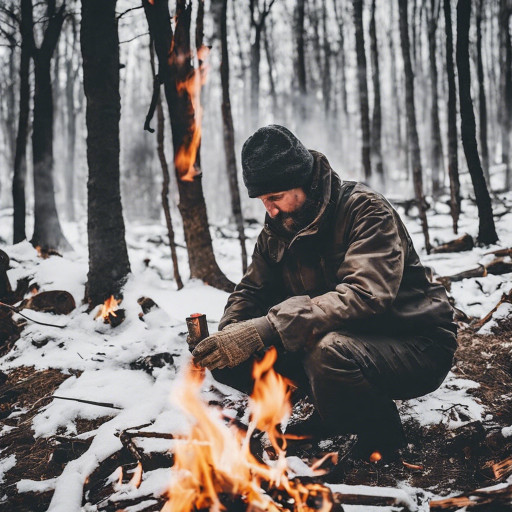Master Fire Starting Skills for Survival in Freezing Temperatures
Starting a fire in freezing temperatures is not merely a skill—it’s a crucial necessity for survival in the face of winter’s harsh realities, including biting cold and relentless winds. For those who embrace the survivalist lifestyle, the role of fire extends beyond warmth; it provides essential light, enables cooking, and fosters a sense of security in the wilderness. However, lighting a fire in icy conditions presents unique challenges that require specific techniques and strategies. This comprehensive guide delves into the most effective methods for igniting flames in cold weather, equipping you with the essential knowledge and skills to not only endure but thrive amid winter’s harsh grip.
Essential Gear and Supplies: Prepare Your Fire Starting Kit for Success
Before you venture into the winter wilderness, it’s vital to prepare yourself with the right gear and supplies that can dramatically increase your chances of survival. A well-equipped fire-starting kit can be a game changer when facing adverse weather conditions. Start by ensuring your kit includes the following crucial items:

a. Firestarters: Invest in reliable tools such as waterproof matches, storm-resistant lighters, and fire-starting rods. These items are essential for ensuring ignition, even when faced with obstacles like wind and moisture. Having multiple reliable options will empower you to start a fire, no matter the difficulties presented by the environment.
b. Dry Tinder: Finding dry tinder in freezing temperatures can be incredibly challenging. Prepare for this by packing highly flammable materials such as birch bark, fatwood shavings, and cotton balls soaked in petroleum jelly. These components not only ignite quickly but also significantly boost your chances of successfully starting a fire when the mercury dips below freezing.
c. Kindling: To build a solid foundation for your fire, gather dry sticks, twigs, and leaves. Ensure that these materials are thoroughly dry, as any moisture can impede ignition, leading to frustration during your fire-starting attempts. Well-prepared kindling is essential for creating a smooth transition from tinder to a stronger, more enduring flame.
d. Fuel: Sourcing dry firewood in frigid temperatures can be both labor-intensive and time-consuming. Therefore, it’s critical to have an ample supply of dry firewood ready in advance. This foresight ensures that you can maintain a steady fire for an extended period, keeping you warm and enabling you to cook food comfortably.
Strategically Choose Your Fire Location for Maximum Efficiency
When the temperature drops, selecting the perfect spot for your fire can provide significant benefits. Look for sheltered areas, such as rock formations or dense shrubbery, to reduce exposure to harsh winds. By positioning your fire near a natural windbreak, you can minimize heat loss and enhance the likelihood of maintaining a steady flame. Moreover, consider constructing a small wind-resistant shelter using logs or a tarp to shield your fire from moisture and preserve warmth, ultimately improving your comfort and safety during your outdoor adventure.
Utilize the Layering Technique for Long-Lasting and Effective Fires
One of the most critical techniques for successfully starting a fire in cold weather is mastering the art of layering your materials. To create a fire that burns steadily, you must effectively utilize the three foundational layers: tinder, kindling, and fuel. Here’s a breakdown of each layer and its importance:
a. Tinder: The first layer, known as tinder, consists of materials that ignite quickly and easily. Opt for fine, dry substances such as grass, paper, or birch bark to ensure a robust initial flame. Having an ample supply of tinder is vital for achieving successful ignition, particularly in cold environments where conditions can be less forgiving.
b. Kindling: This layer comprises small sticks and twigs that ignite rapidly and produce sustained heat. Gradually introduce kindling to your flame, making sure to leave enough space between pieces to facilitate airflow and encourage combustion. This step is essential for transitioning from small flames to a larger, more stable fire that can provide warmth for longer periods.
c. Fuel: Once you have established a steady flame, begin adding larger pieces of firewood. Ensure this wood is dry, as it will burn longer and generate more heat. Increase the size of the wood pieces gradually, allowing the flames to strengthen before introducing larger logs. This strategic layering approach fosters a stable and sustainable fire that can withstand the challenges of cold weather.
The layering technique creates a structured setup that allows flames to expand and sustain themselves effectively. Always ensure you have an adequate supply of each component readily available to facilitate a seamless transition from tinder to fuel, maximizing your success in challenging conditions.
Enhance Your Fire-Starting Success with Proven Techniques and Aids
In bitterly cold weather, using additional fire-starting aids can significantly boost your chances of successfully igniting a fire despite low temperatures. Here are some effective methods to consider incorporating into your fire-starting strategy:
a. Fatwood: Often referred to as nature’s firestarter, fatwood is resin-rich pine wood that ignites easily and burns with intense heat. You can collect these naturally occurring sticks from fallen pine trees or purchase them from outdoor supply retailers. A few pieces of fatwood can dramatically enhance your chances of successfully starting a fire in extremely cold conditions.
b. Alcohol-Based Hand Sanitizer: Surprisingly effective, alcohol-based hand sanitizer is highly flammable and can act as an accelerant. A small amount applied to your tinder or kindling can facilitate rapid ignition, even in damp conditions, simplifying the fire-starting process and ensuring you remain warm when it matters most.
c. Char Cloth: Char cloth is specially prepared fabric that ignites easily from sparks, making it an excellent tool for starting fires using flint and steel or a lighter in difficult situations. Its lightweight and portable nature makes it an ideal addition to your fire-starting kit, ensuring you are always prepared for any fire-starting scenario.
Incorporating these fire-starting aids into your cold-weather toolkit can significantly enhance your chances of success when confronted with particularly challenging conditions, allowing you to adapt effectively to your environment.
Explore Effective Fire Techniques Designed for Cold Weather Conditions
As a committed survivalist, continually refining your skills is crucial to your success. Here are two exceptional fire techniques that excel in cold weather:
a. Swedish Torch: Also known as a Canadian Candle or Finnish Fire Log, the Swedish Torch is an incredibly effective fire-starting method. This technique provides a stable and long-lasting flame, ideal for combating the winter chill. To create a Swedish Torch, locate a knee-height log and cut several vertical slits along its length. Fill the slits with tinder and ignite it. The log will serve as a consistent fuel source, allowing the flame to endure for an extended period, ensuring warmth and safety.
b. Dakota Fire Hole: When faced with strong winds, the Dakota Fire Hole method is extremely effective. This technique involves digging a hole and tunneling horizontally underground to create an airflow vent. This design harnesses wind to improve airflow, resulting in a more efficient fire that is less likely to be disrupted by gusts. Additionally, the Dakota Fire Hole method effectively reduces visible smoke while conserving fuel, making it an excellent choice for discreet fire building.
Regardless of the method you choose, always prioritize safety and responsible fire management to minimize risks and ensure a successful fire-starting experience.
Successfully igniting a fire in cold weather demands careful planning and execution. By following these steps—preparing a reliable fire-starting kit, selecting a suitable location, mastering layering techniques, utilizing fire-starting aids, and adopting specific fire strategies—you will greatly enhance your chances of success. Remember, practice makes perfect, so consistently train to refine your skills and build your confidence. With these essential tactics for igniting fires in freezing conditions in your arsenal, you’ll be well-equipped to face even the harshest winters that nature can present. Stay warm, prioritize safety, and keep the flames of survival alive!
The post Fire Starting Methods for Survivalists in Cold Weather appeared first on Survival Bite.
The Article Fire Starting Techniques for Cold Weather Survival Was Found On https://limitsofstrategy.com

This is such an important topic, especially for those of us who enjoy winter camping or hiking in remote areas. From personal experience, I’ve found that the choice of fire-starting materials can make a huge difference in frigid conditions. For instance, carrying a mix of tinder—like dryer lint or fatwood—combined with waterproof matches can speed up the process significantly when the wind is howling and everything is damp.